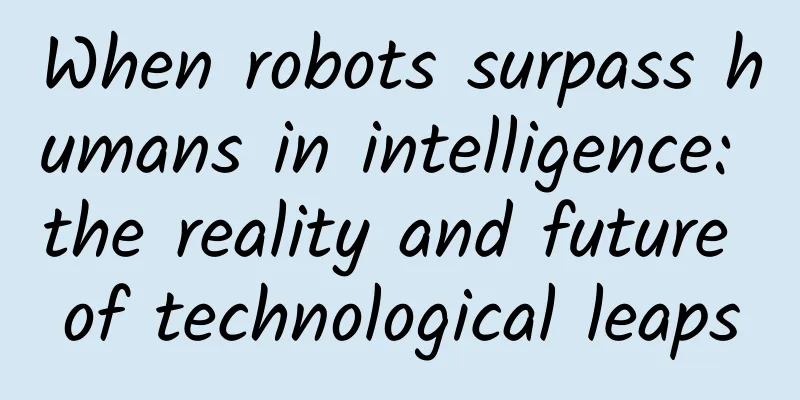When robots surpass humans in intelligence: the reality and future of technological leaps

|
Author Duan Yuechu In today's era of rapid technological development, robots are no longer magical things that only exist in science fiction movies. They are striding into our daily lives. Take the sweeping robot for example. It can move freely around the house and clean the floor, so that office workers can enjoy a clean environment when they return home after a busy day. There are also those mechanical arms that work tirelessly in automobile manufacturing factories. They accurately complete various assembly tasks, greatly improving production efficiency. As artificial intelligence technology "soars" all the way, a question that people have to think about seriously is placed before us: Will robots evolve to have an IQ higher than that of humans? If there really comes such a day, what should humans do? Will they really be controlled by robots and become their "followers" as some people worry? Or can humans and robots live in harmony and create a new world together? The evolution of robots: from embryonic development to intelligence Looking back at the development of robots, it is simply a passionate struggle history of human wisdom and technological progress. Back in the 1940s and 1950s, in order to free themselves from heavy and dangerous work, especially in environments full of radioactive pollution such as nuclear testing, humans at that time began to think about using machines to replace manpower. The Argonne National Energy Laboratory in the United States took the lead and developed a teleoperated manipulator specifically for handling radioactive materials that could not be touched. Later, it developed an electrically driven master-slave manipulator arm, so that experimenters no longer had to work in fear. In 1954, American inventor George Devol made the world's first polar coordinate manipulator equipped with a programmable controller and published a patent. This was amazing and marked the initial appearance of robots. In 1959, Devol and Joseph Engelberger teamed up to create the first industrial robot prototype Unimate, and also established the world's first industrial robot manufacturing factory Unimation. From then on, robots officially "debuted" on the stage of history. However, the robots at that time were still very immature, with very few functions, and could not cope with more complex industrial production scenarios at all. In the 1960s and 1970s, robots entered the initial stage of growth. After the end of World War II, many places in the world were short of labor. The defeated countries such as Japan and Germany were busy with post-war reconstruction, and the manpower was very tight, which forced people to find ways to replace manual labor. In 1962, General Motors of the United States installed the first Unimate industrial robot of Unimation, and the first generation of teaching and reproducing robots was born. During this period, industrial robots became more and more commercialized and began to move towards industrialization. The automobile production industry took the lead in using robots in large quantities. These robots are very good at handling, painting, arc welding and other tasks, which not only solved the problem of labor shortage, but also greatly improved production efficiency and product quality. Moreover, humans have been liberated from those monotonous and tiring production operations and can do more technical work. In 1978, Unimation launched the Puma series of all-electric, articulated general industrial robots, and in 1979, the plane-jointed Scara robot suitable for assembly operations was also launched. At this point, the technical system of the first generation of industrial robots has become complete and mature. Japan is particularly good at this. After introducing robot technology from the United States, because the domestic labor gap is too large, the government has vigorously supported it, providing subsidies, technical guidance, and low-interest loans, which immediately set off a wave of research and manufacturing of robots. Japan has become a major country in robot research and development and manufacturing. In the 1980s and 1990s, robots ushered in a golden period of rapid development. The production industry has changed from the original "mass production automation" to "small batch multi-variety production automation", and the requirements for production flexibility have become higher and higher, which has prompted another innovation in robot technology. In 1965, the Massachusetts Institute of Technology in the United States developed a robot test machine that can sense and identify blocks and automatically stack blocks without people worrying about it. This is a landmark event for the birth of the second generation of robots. From then on, perception function has become the focus of robot research and development. In the early 1980s, General Motors in the United States installed a visual system on the industrial robots on the automobile assembly line, which means that the second generation of industrial robots with basic perception functions was born. Compared with the first generation, the second generation of robots is not only more efficient, but also has better product consistency and interchangeability. It also has stronger perception and adaptability to the external environment, can complete more complex tasks, and is no longer limited to those simple and repetitive tasks. During this period, Japan's industrial robot industry chain was particularly complete and large in scale, and it suddenly became the "robot kingdom". Japan is the country that uses and manufactures the most robots in the world. Entering the 21st century, robots have begun to stride towards intelligence. Although the second-generation robots can already sense the outside world and complete quite complex tasks, there is still a key step away from a true "unmanned factory", which is to give robots logical thinking and decision-making capabilities. In the late 1990s, computer technology and artificial intelligence technology developed rapidly, bringing breakthroughs to the research of the third-generation intelligent robots. The third-generation intelligent robots use advanced control methods such as artificial intelligence, fuzzy control, and neural networks. Under the control of intelligent computers, they perceive their own status and operating environment through many sensors, reason and make decisions with the support of knowledge bases, and can also perform multivariable real-time intelligent control on themselves. Now, our country has also become a major country in robot research, manufacturing, and application. Once "Made in China 2025" was proposed, the trend of intelligent and unmanned industrial production has become more obvious. With the continuous emergence of new technologies, the future development of intelligent robots is full of infinite possibilities. The competition between robot IQ and human intelligence: current situation and gap Whether robots can surpass humans in intelligence has always been a hot topic. But to be honest, the so-called "intelligence quotient" (IQ) of robots and human intelligence are completely different things. Although robots are particularly good in certain specific aspects and even surpass humans, from an overall and comprehensive perspective, they are still far behind human intelligence. In terms of narrow intelligence, most robots now belong to "narrow AI". They are good at doing specific things, such as playing chess, image recognition, and natural language processing. In these tasks, robots rely on their super computing power and data processing speed to often beat humans, both quickly and accurately. Take AlphaGo for example, it defeated the top human players in the field of Go, which made the world see the powerful strength of artificial intelligence in specific fields. However, this kind of robot has no self-awareness and limited understanding ability. It can only play a role in a small circle that has been set. Once it exceeds the scope, it will be at a loss. Generalized artificial intelligence (AGI) is different. It aims to simulate the comprehensive intelligence of humans, allowing machines to have flexible thinking, consciousness and emotions like humans, to handle various tasks across domains, and to have high-level cognitive abilities such as learning, reasoning, emotional understanding and creativity. Unfortunately, AGI technology has not yet been realized, which is also a major obstacle in the development of robot intelligence. In terms of computing power and information processing, machines have indeed left humans behind. Some AI can analyze and process large amounts of data in seconds, perform super-complex mathematical calculations, and make predictions, which take humans hours or even longer to complete. For example, in the financial field, artificial intelligence can quickly analyze massive amounts of market data and provide reference for investment decisions; in scientific research, robots can help scientists process complex experimental data and speed up scientific research progress. However, this "surpassing" of machines is only for specific tasks, and it cannot be said that they have the same comprehensive intelligence as humans. Human intelligence is not only based on logical reasoning and data processing, but also has many characteristics that robots currently do not have. Take emotional intelligence for example. Humans can understand and feel all kinds of emotions. When they see others are sad, they can empathize with them and offer care and comfort. When artists create, emotions are the source of inspiration. But robots can only recognize and respond to emotions according to preset programs and algorithms. They have no real emotional experience and cannot empathize. There is also creativity and intuition. Humans are particularly good at establishing wonderful connections between different fields and creating new ideas, new methods and new works. Scientists can come up with new theories and new hypotheses based on their intuition and insight. Robots are not like this. They mainly rely on algorithms and rules written by humans. They do not have the ability to innovate and associate independently, so it is difficult for them to have truly creative thinking. Let's talk about moral and ethical judgment. When humans make decisions, they will consider social, cultural, emotional and other factors and make choices that meet moral and ethical standards. Faced with moral dilemmas, humans will weigh them according to their own values and moral standards. Robots can only judge based on data and preset rules. They have no independent ethical awareness and are dumbfounded when faced with complex moral situations. The possibility and potential impact of robots surpassing human intelligence Although robots currently lag behind humans in IQ, theoretically, if AGI (generalized artificial intelligence) is realized in the future and robots have self-awareness and autonomous learning capabilities, it is not impossible for their intelligence to surpass humans in some aspects, especially in knowledge processing speed and information storage. As technology continues to advance and artificial intelligence algorithms are continuously optimized, robots will demonstrate capabilities that surpass humans in more areas, and this possibility is increasing. If robots' IQs really exceed those of humans, the impact on human society will be huge. On the bright side, robots can help humans solve many complex problems and promote the rapid development of science and technology. In the medical field, intelligent robots can diagnose diseases more accurately, perform surgeries more precisely, and save more lives; in environmental protection, robots can monitor and analyze environmental data, formulate more effective environmental protection strategies, and protect our home planet; in scientific research, robots can speed up the scientific research process and help humans explore more unknown areas. However, robots’ IQ surpassing that of humans also brings many potential risks and challenges. Take the employment issue for example. Robots are becoming more and more popular in various fields, and they have taken away a large number of repetitive and regular jobs. This has led to many people losing their jobs, especially those with less skills. The employment pressure will be particularly high, and the employment structure of society will also change greatly. How to solve this problem and enable the smooth transformation and upgrading of the labor force is a big challenge we must face. There are also ethical and social issues. When robots have high intelligence and autonomous decision-making capabilities, how to balance the rights and obligations of robots and humans and protect human dignity and rights becomes a big problem. For example, do the decisions of robots conform to human ethical standards? If the behavior of robots harms humans, who should bear the responsibility? In addition, will the intelligence and emotions of robots affect human thinking and emotions, and change human values and social concepts? This is also worth our careful consideration. From a more macro perspective, if robots are much smarter than humans, will humans really become "slaves" of robots and lose control of the world? This is very worrying. Although it is still uncertain how the future will develop, we must prepare in advance and formulate corresponding laws, regulations and ethical standards to guide the healthy development of robot technology. Human advantages and coping strategies: working together or confronting each other fiercely? Although robots seem to have the potential to surpass humans in some aspects, humans also have many advantages that robots cannot match. In addition to the emotional intelligence, creativity and intuition, moral and ethical judgment mentioned above, humans also have rich social experience, cultural background and interpersonal skills. These advantages allow humans to flexibly respond to various situations in a complex social environment and establish deep interpersonal relationships and social networks. Faced with the trend that robots may surpass humans in intelligence, humans must take active measures to deal with it. We must attach importance to the research and development and management of robot technology. When developing, we must keep the safety and controllability of the technology in mind to ensure that the behavior of robots serves the interests of mankind and conforms to human values. At the same time, we must strengthen supervision of artificial intelligence algorithms and prevent problems such as algorithm bias and discrimination from occurring. Education and training should also be stepped up to comprehensively improve the overall quality and skills of human beings. We should cultivate talents that can adapt to the needs of the new era, so that everyone can engage in more advanced and creative work and reduce their dependence on repetitive and regular work. We can carry out more education on emerging technologies such as artificial intelligence, big data, and cloud computing to cultivate more scientific and technological talents; we should also focus on cultivating humanistic qualities and innovation capabilities to enhance human competitiveness. In addition, we must vigorously promote the development of human-machine collaboration. Humans and robots are not enemies, they can complement and promote each other. Through human-machine collaboration, the respective advantages of humans and robots can be brought into play, and work efficiency and production benefits can be greatly improved. In the medical field, doctors and medical robots cooperate to perform surgery together, and the success rate of the surgery is definitely higher; in industrial production, workers and industrial robots work together to complete more complex production tasks. |
<<: DeepSeek provides its own prompts, with templates and examples, making it more efficient to use!
>>: So that's it! The "flow of time" in the hourglass is actually like this | Science Museum
Recommend
"Transformation" and "crossover" under the new situation allow home appliances to better understand people's hearts!
Preface Affected by the novel coronavirus pneumon...
Marketing techniques and routines for screen-sweeping events!
Case 1: The movie "The Last Night on Earth&q...
Breaking news: The mayor of Miami has been confirmed to have tested positive for the new coronavirus!
[The mayor of Miami in the United States tested p...
Using RenderScript to achieve Gaussian blur (frosted glass/frosted) effect
Preface When browsing Instagram, I accidentally d...
80 episodes of video on how Gu Yu became a professional trader
80 episodes of Gu Yu's video on how to become...
Taking "The Debaters" as an example: How can popular content extend its life cycle?
The latest season of " The Debaters " i...
The four most common types of pimples on the hands, face, and neck may not be ordinary skin diseases!
When it comes to HPV (human papillomavirus), dise...
The report says that Android will account for 82.6% of the market share in 2019
The competition between iOS and Android has enter...
A well-known singer died of illness. What is the culprit, "melanoma"?
Audit expert: Zhang Yuhong Chief Physician of Der...
Lin Yu_Course Creation Methodology Baidu Cloud Download
Lin Yu_Course Creation Methodology Lin Yu Course ...
Full-network marketing, one marketing matrix can do it all!
Concepts in the marketing field are different fro...
Customized video of a foreigner shouting "Happy Birthday"! Creatively customized video of a black African child holding a sign to wish a happy birthday!
Our African team is professional in shooting bles...
AE animation tutorial video "The Secret of Keyframes"
Training course content: It covers every aspect o...
2015: A New Era of Mobile Payment
[[125693]] On December 28, the American technolog...
9 things you need to know about Google IO 2015
[[135288]] 1 Google officially releases Android M...









